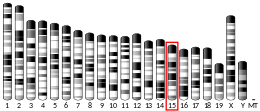Matrilin-2
Matrilin-2 is a matrilin protein that in humans is encoded by the MATN2 gene.[5][6][7]
This gene encodes a member of the von Willebrand factor A domain containing protein family. This family of proteins is thought to be involved in the formation of filamentous networks in the extracellular matrices of various tissues. This protein contains five von Willebrand factor A domains. The specific function of this gene has not yet been determined. Two transcript variants encoding different isoforms have been found for this gene.[7]
References
- GRCh38: Ensembl release 89: ENSG00000132561 - Ensembl, May 2017
- GRCm38: Ensembl release 89: ENSMUSG00000022324 - Ensembl, May 2017
- "Human PubMed Reference:". National Center for Biotechnology Information, U.S. National Library of Medicine.
- "Mouse PubMed Reference:". National Center for Biotechnology Information, U.S. National Library of Medicine.
- Deak F, Piecha D, Bachrati C, Paulsson M, Kiss I (May 1997). "Primary structure and expression of matrilin-2, the closest relative of cartilage matrix protein within the von Willebrand factor type A-like module superfamily". J Biol Chem. 272 (14): 9268–74. doi:10.1074/jbc.272.14.9268. PMID 9083061.
- Mates L, Korpos E, Deak F, Liu Z, Beier DR, Aszodi A, Kiss I (Mar 2002). "Comparative analysis of the mouse and human genes (Matn2 and MATN2) for matrilin-2, a filament-forming protein widely distributed in extracellular matrices". Matrix Biol. 21 (2): 163–74. doi:10.1016/S0945-053X(01)00194-9. PMID 11852232.
- "Entrez Gene: MATN2 matrilin 2".
Further reading
- Muratoglu S, Krysan K, Balázs M, et al. (2001). "Primary structure of human matrilin-2, chromosome location of the MATN2 gene and conservation of an AT-AC intron in matrilin genes". Cytogenet. Cell Genet. 90 (3–4): 323–7. doi:10.1159/000056797. PMID 11124542.
- Frank S, Schulthess T, Landwehr R, et al. (2002). "Characterization of the matrilin coiled-coil domains reveals seven novel isoforms". J. Biol. Chem. 277 (21): 19071–9. doi:10.1074/jbc.M202146200. PMID 11896063.
- Piecha D, Hartmann K, Kobbe B, et al. (2002). "Expression of matrilin-2 in human skin". J. Invest. Dermatol. 119 (1): 38–43. doi:10.1046/j.1523-1747.2002.01789.x. PMID 12164922.
- Piecha D, Wiberg C, Mörgelin M, et al. (2002). "Matrilin-2 interacts with itself and with other extracellular matrix proteins". Biochem. J. 367 (Pt 3): 715–21. doi:10.1042/BJ20021069. PMC 1222949. PMID 12180907.
- Strausberg RL, Feingold EA, Grouse LH, et al. (2003). "Generation and initial analysis of more than 15,000 full-length human and mouse cDNA sequences". Proc. Natl. Acad. Sci. U.S.A. 99 (26): 16899–903. doi:10.1073/pnas.242603899. PMC 139241. PMID 12477932.
- Clark HF, Gurney AL, Abaya E, et al. (2003). "The secreted protein discovery initiative (SPDI), a large-scale effort to identify novel human secreted and transmembrane proteins: a bioinformatics assessment". Genome Res. 13 (10): 2265–70. doi:10.1101/gr.1293003. PMC 403697. PMID 12975309.
- Ota T, Suzuki Y, Nishikawa T, et al. (2004). "Complete sequencing and characterization of 21,243 full-length human cDNAs". Nat. Genet. 36 (1): 40–5. doi:10.1038/ng1285. PMID 14702039.
- Gerhard DS, Wagner L, Feingold EA, et al. (2004). "The status, quality, and expansion of the NIH full-length cDNA project: the Mammalian Gene Collection (MGC)". Genome Res. 14 (10B): 2121–7. doi:10.1101/gr.2596504. PMC 528928. PMID 15489334.
- Otsuki T, Ota T, Nishikawa T, et al. (2007). "Signal sequence and keyword trap in silico for selection of full-length human cDNAs encoding secretion or membrane proteins from oligo-capped cDNA libraries". DNA Res. 12 (2): 117–26. doi:10.1093/dnares/12.2.117. PMID 16303743.
- Sharma MK, Watson MA, Lyman M, et al. (2006). "Matrilin-2 expression distinguishes clinically relevant subsets of pilocytic astrocytoma". Neurology. 66 (1): 127–30. doi:10.1212/01.wnl.0000188667.66646.1c. PMID 16401863.
- Lim J, Hao T, Shaw C, et al. (2006). "A protein-protein interaction network for human inherited ataxias and disorders of Purkinje cell degeneration". Cell. 125 (4): 801–14. doi:10.1016/j.cell.2006.03.032. PMID 16713569.
This article is issued from Wikipedia. The text is licensed under Creative Commons - Attribution - Sharealike. Additional terms may apply for the media files.




